Holiday Special: Dressing Up

Dressing up is fun, whether it’s a costume to go out trick or treating at Hallowe’en or our best clothes for a wedding or other special occasion. Some animals dress up too. Here are just a few examples.
Caddisfly
Caddisflies are moth-like insects. As adults they live on land, but the larvae and pupae are found in freshwater environments such as streams, lakes, or ponds. Many of the larvae are able to secrete a sticky silk from their salivary glands which they use to glue grains of sand, small pieces of bark, sticks, leaves, and mollusc shells to the outside of a tubular silk case. Each genus of cuttlefish uses the same identifiable design and materials to make their case. The tube protects them as they move around underwater, feeding on decaying vegetable matter. As the larvae grow, they add more material to the front of their case. They can even turn around and trim the rear end of the case so it doesn’t drag on the ground.
See also: Photos of caddisfly larvae [University of Guelph, The Arboretum]
Cuttlefish
Cuttlefish are related to octopus and squid. Like other colour-changing animals, they can flex the muscles surrounding tiny sacs of pigment (chromatophores) in their skin to reveal the colour inside. But cuttlefish are special as their chromatophores are directly wired to the brain so they can change colour very quickly.
Cuttlefish change colour to hide, hunt, and communicate. They even change colour in their sleep, which has led scientists to wonder if the changing colours reflect their thoughts or even dreams. Initial research has found that “while cuttlefish do show patterns on their skin as they’re sleeping, they don’t directly match the colorations the animals made when they were awake. However, some of the sleep-induced patterns did appear to be partial, more abstract versions of those the cuttlefish made during social interactions.”
See also: Cuttlefish and Their Amazing Technicolor Dreamcoat [Hakai Magazine]
Decorator Crabs
Decorator crabs camouflage themselves with algae and small sedentary animals such as anemones. The pieces of algae or small animals are attached to hooked, velcro-like bristles on the crab’s upper shell. As the crab grows, it sheds its old shell and forms a newer, larger one. The crab carefully removes the decorations from its old shell and attaches them to the new one.
The decorations camouflage the crab, helping it to blend in with its environment. If a crab moves from one location to another, it will update its decorations to match its surroundings, substituting seaweed for small shells and gravel or vice versa. Some crabs choose decorations that will protect them and help to ward off predators by attaching stinging or poisonous organisms to their shell.
See also: Meet the Decorator Crab [Monterey Bay Aquarium]
Photo credit: https://www.flickr.com/photos/apmckinlay/8449976728
EcoFriendly West informs and encourages initiatives that support Western Canada’s natural environment through its online publication and the Nature Companion website/app. Like us on Facebook, follow us on Twitter or Mastodon, or subscribe by email.

Member discussion